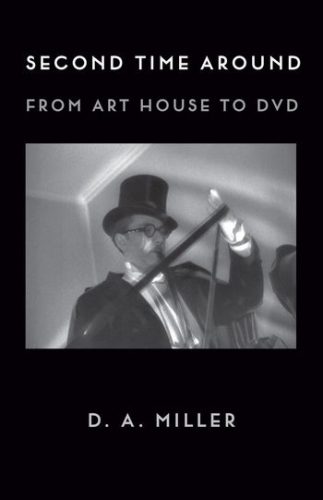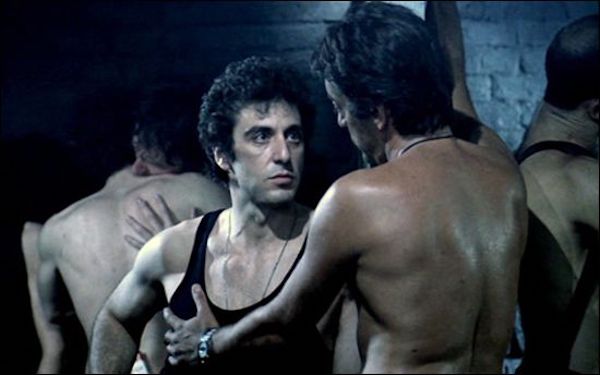Book Review: “Second Time Around: From Art House to DVD”
By Gerald Peary
The book’s conceit is that D.A. Miller watches films he’s seen earlier in life with enhanced perception because of the possibilities offered him through the DVD lens.
Second Time Around: From Art House to DVD by D.A. Miller. Columbia University Press, 264 pages, $25 (paperback)
Buy at Bookshop
 Film scholar and academician D.A. Miller had his intense movie education in the same era as I did, the ’60s and ’70s. We traveled everywhere for legendary, hard-to-see movies, sometimes watching them in compromised circumstances. I saw classic films projected on walls in people’s apartments, or on a pull-down screen at a dining co-op after the dinner dishes were cleared. Too often the 16mm prints were scratchy ones with missing frames and muddy shadows and human hairs flickering in the frame.
Film scholar and academician D.A. Miller had his intense movie education in the same era as I did, the ’60s and ’70s. We traveled everywhere for legendary, hard-to-see movies, sometimes watching them in compromised circumstances. I saw classic films projected on walls in people’s apartments, or on a pull-down screen at a dining co-op after the dinner dishes were cleared. Too often the 16mm prints were scratchy ones with missing frames and muddy shadows and human hairs flickering in the frame.
As Miller describes the viewing experience: “Your eyes were always trying to puzzle out the palimpsest of the original film that lay dimly discernible under a dense patina of dirt, lines, snow…” More agonizing for Miller, the majestic film he was trying to grasp in all its subtleties moved so quickly on its course that he could barely make sense of it. As I vividly remember, the film was pulled from the projector and went back into its box, to be mailed on to its next set of eyes.
But moving ahead a few decades and—voila!—Miller’s frustrations are assuaged in the age of the DVD. That maimed and mutilated 16mm film is now available to be watched on his computer or television screen in pristine condition from a 35mm negative. And hallelujah for remote control: “I now hold the reins…and in general perform all those retrievals once merely wished for but now realized as routine functions: pause, step, forward, back, slow, fast, skip, grab bookmark…a fantastic intimacy with the film image, which I can now manipulate from only a couple of feet away.”
The quotations above are from Miller’s introduction to Second Time Around: From Arthouse to DVD. The 13 essays in this collection are culled from Miller’s long-running column in Film Quarterly with the same title, “Second Time Around.” The conceit is that he watches films he’s seen earlier in life with enhanced perception because of the possibilities offered him through the DVD lens. Says Miller, “Inevitably, it’s then versus now: my potent, if patchy memory of the film contends with the harsh precision of its recaptured images.”
OK, that sounds fine and fair. I prepared myself for a book in which the erudite author will compare his remembrances from his first seeing a film on screen with what, many years later, he catches on DVD. His cinephilia youth versus his life as a seasoned film writer and a senior film professor.
The Second Time Around? Hardly. The book’s title is deceptive, erroneous. Many of the volume’s essays are valuable, but it’s rarely because we are privy to the shifts in Miller’s perspective from his initial viewings of films to later ones. In fact, the earlier viewings are usually skipped over entirely. Instead, Miller plunges into his contemporary readings of films as if he’s never seen them before.
And what is his approach in these essays? Miller acknowledges he’s reverting unfashionably to New Criticism, to close readings of the texts. Still, there is literary theory around the edges, references to Deleuze and Foucault. A more direct influence is the Roland Barthes of Mythologies, who produced short essays like these and who broke down cultural barriers as to what is worthy of analysis. Why else would Miller devote an essay to H-Man, a campy, barely known 1958 Japanese sci-fi allegory? Miller is also reminiscent of Pauline Kael in the certitude of his insights, and his assumption that readers will take whatever he expounds as gospel. Finally, I don’t know if it is conscious, but Miller attacks films in the way of the late critic Manny Farber, burrowing into the body of a movie at his point of interest, only vaguely concerned with unveiling the plot or setting up the film as a whole for readers.
Why these films and not others? I have no inkling. The choices seem arbitrary, just movies that on a whim Miller wants to write about. If they resonated in Miller’s past, he almost never tells us how. Of the movies he discusses, the majority are European art films. There are also some “auteur” American films. And there’s H-Man.
Miller starts, only he knows why, with pages on Kenji Mizoguchi’s 1954 masterpiece, Sansho the Bailiff. In this case, he does follow through on what he promises in his introduction, postulating that, in 16mm days, bad, degraded prints of this Japanese film helped create the mystique of a humanist fable. In contrast, the crystalline DVD from the Criterion Collection shows a much icier movie, revealing Mizoguchi’s elegant form in contrast to the down-and-out tale of suffering.
Perhaps.
In his Sansho essay, Miller also goes after a repeated target of his derision, the commentary track arriving as part of the DVD package. He finds that critics with this mission either have nothing to say, filling the air with worthless trivia, or too much to say but don’t have time to say it because the movie keeps moving on. Salient points. In the case of Sansho, Miller criticizes the “pseudo-visuality” of the critic’s voice-over, objecting to phrases like “the use of space is reminiscent of pre-modern Japanese scroll paintings and woodblock prints that activate the foreground with some sort of dramatic moment.” I don’t comprehend Miller’s complaint. Though a bit dry and scholarly, that description makes sense to me.
So what does Miller himself have to offer us about Sansho? Something too specific and rarified for readers, an extended, tedious analysis of “two shots fluently seamed together” in the middle of the film. I will say it. Who cares?

Al Pacino in a scene from 1980’s Cruising — where Hollywood never ventured before.
His chapter on William Friedkin’s 1980 picture Cruising is far more lively and interesting, a queer reading of the once-infamous film in which a self-proclaimed straight director took his camera into the bowels of a pre-AIDS leather bar in which literally anything sexual goes. While some gay advocates declared the film homophobic, Miller applauds it for going where Hollywood never ventured before, “through the darkness of bars whose patrons are as likely to be sucking dick as swilling beers—and where even that beer seems destined to be pissed out on men expectantly waiting in bathtubs for the purpose.”
The more sexually transgressive the acts that Miller describes in Cruising, the more you feel his erotic excitement. It’s palpable. And yet never in this essay does the author say, “I’m gay.” Why not? Why does the closet remain? And especially since Miller keeps returning to queerness in cinema for his most inspired, unorthodox interpretations. Unexpected queerness is shown subverting La Ronde, by Max Ophuls, a heterosexual director. More queerness even than is obvious is pulled out of Visconti’s Rocco and His Brothers and Pasolini’s Medea, films by openly gay Italian filmmakers.
Should I mention that Miller is a contrarian? He has an essay about watching anew Bonnie and Clyde and Pierrot le fou, and he ends up disliking both well-regarded films. He translates into English for the first time a Barthes essay on New Wave French cinema, and then dumps on the revered French author for his wrong-headed reading of Claude Chabrol’s Le Beau Serge.
Miller ends his book with an outstanding extended essay on his all-time favorite film, Hitchock’s The Birds. And here we do learn that he’s been watching it compulsively for half a century, and that he’s also been an obsessive fan, purchasing lobby cards and posters in many languages, and even attending a meet-and-greet with star Tippi Hedren so he could secure her autograph. He’s also a San Francisco native who has traced down all the iconic local spots of the film’s legendary shooting.
But these days, Miller—increasingly paranoid as he ages?—regards watching his beloved The Birds with distress. “I now steel myself against images I once eagerly met head on.” He takes seriously the breaking of glass by the birds in the movie as an attack on the camera lens and ultimately on us, the audience. And how frightening that Hitchcock ends with a shot high in the sky, a “bird’s eye” view, making it clear whose vision has usurped the world. Miller quotes Lydia in the movie as his final words in the book, his unnerved epitaph for Second Time Around: “this business with the birds has upset me.”
Gerald Peary is a Professor Emeritus at Suffolk University, Boston, curator of the Boston University Cinematheque, and the general editor of the “Conversations with Filmmakers” series from the University Press of Mississippi. A critic for the late Boston Phoenix, he is the author of nine books on cinema, writer-director of the documentaries For the Love of Movies: the Story of American Film Criticism and Archie’s Betty, and a featured actor in the 2013 independent narrative Computer Chess. His new feature documentary, The Rabbi Goes West, co-directed by Amy Geller, is playing at film festivals around the world.
